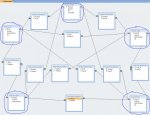Hello everyone, self-taught access for a couple months now, and I'm having trouble trying to figure out how to set up a query. In the end, it should look exactly like the attached image if someone chooses the product FSC 1957. There are 5 "buckets" the user can choose from. Product, IF IP, AMS IP, Flex IP, and Features. These are all displayed on an unbound form for the user to choose. The Product bucket is a combobox bound to the Product Table and the rest of the buckets are displayed as subforms in datasheet view with each Source Object as the corresponding table. All of these tables are in a many-to-many relationship with the others (Product to IF IP, Product to AMS IP, Product to Flex IP, Product to Features, IF IP to AMS IP and so on and so forth). I have junction tables set up for each many-to-many relationship and everything works perfectly. What I want my query to do is to show why each item was selected (whether it was directly related to a product, or if it was related to an AMS IP which came from an IF IP which is directly related to the product). In a sense there is a bit of hierarchy, but a very messy one because the data being put into it is still in development so certain items are kind of floating, but everything does have a relationship to something. I know outer joins are needed and I believe I will have ambiguous outer joins if this was to be set up in one go. Where I'm struggling is to figure out how to actually set it up to have it display like the attached image. I'm under the impression that to do this, I will need a lot of queries. In the sample image, FSC 1957 has IF IP 1 under it, under IF IP 1 is AMS IP 1.0, under AMS IP 1.0 is LDO_1, and LDO_1 has no features under it. AMS IP 1.0 has Feature A under it with no associated Flex IP, IF IP 1 has Feature D under it with no associated Flex or AMS IP, then FSC 1957 has AMS 2.1 under it with no associated IF IP, and under AMS 2.1 is BC1.2_1 Flex IP, and Feature C with no Flex IP.
Let me know if I need to elaborate on something. Seeing as there is a lot of info in words, I'm sure it will be quite confusing and I probably screwed up terminology. Let's hope not! I also would prefer to not use SQL, everything has been done in QBE.
Thanks in advance!
The tables for each "bucket" are:
Product:
Product (PK)
Char Plan (hyperlink field)
IF IP:
IF IP (PK)
Include (Yes/No field)
Best Practices (hyperlink field)
AMS IP:
AMS IP (PK)
Include (Yes/No field)
Best Practices (hyperlink field)
Flex IP:
Flex IP (PK)
Include (Yes/No field)
Best Practices (hyperlink field)
Features:
Features (PK)
Include (Yes/No field)
Best Practices (hyperlink field)
Let me know if I need to elaborate on something. Seeing as there is a lot of info in words, I'm sure it will be quite confusing and I probably screwed up terminology. Let's hope not! I also would prefer to not use SQL, everything has been done in QBE.
Thanks in advance!
The tables for each "bucket" are:
Product:
Product (PK)
Char Plan (hyperlink field)
IF IP:
IF IP (PK)
Include (Yes/No field)
Best Practices (hyperlink field)
AMS IP:
AMS IP (PK)
Include (Yes/No field)
Best Practices (hyperlink field)
Flex IP:
Flex IP (PK)
Include (Yes/No field)
Best Practices (hyperlink field)
Features:
Features (PK)
Include (Yes/No field)
Best Practices (hyperlink field)


